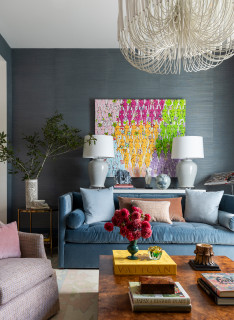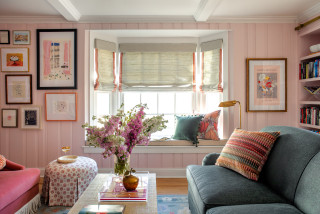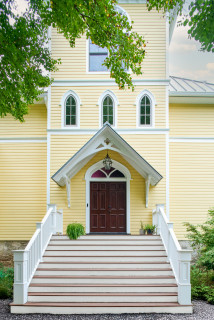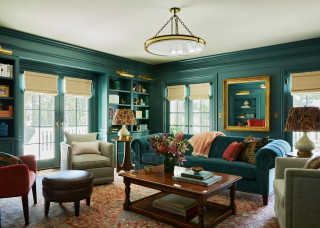
This article was originally published by a www.houzz.com . Read the Original article here. .

This article was originally published by a www.houzz.com . Read the Original article here. .
A slight decline in mortgage rates and limited existing inventory helped new home sales to edge higher in February even as housing affordability challenges continue to act as a strong headwind on the market.
Sales of newly built, single-family homes in February increased 1.8% to a 676,000 seasonally adjusted annual rate from a revised January number, according to newly released data from the U.S. Department of Housing and Urban Development and the U.S. Census Bureau. The pace of new home sales in February was up 5.1% compared to a year earlier.
New home sales have been roughly flat thus far in 2025, as ongoing limited inventory of existing homes in many markets continues to support the need for new homes. Lower mortgage rates helped to lift demand in February, despite other near-term risks such as tariff issues and affordability concerns.
A new home sale occurs when a sales contract is signed, or a deposit is accepted. The home can be in any stage of construction: not yet started, under construction or completed. In addition to adjusting for seasonal effects, the February reading of 676,000 units is the number of homes that would sell if this pace continued for the next 12 months.
New single-family home inventory in February continued to rise to a level of 500,000, up 7.5% compared to a year earlier. This represents an 8.9 months’ supply at the current building pace. The count of completed, ready-to-occupy homes available for sale increased again, rising to 119,000, up 35% from a year ago and marking the highest count since mid-2009.
However, after accounting for a low 3.4 months’ supply for the existing single-family market, total market inventory (new and existing homes) stands at a lean 4.2 months’ supply per NAHB estimates. A balanced market is typically defined as a 6 month’s supply.
The median new home sale price in February was $414,500, down 1.5% from a year ago. The count of sales was supported by a gain of transactions priced between $300,000 and $400,000 in February.
Regionally, on a year-to-date basis, new home sales are up 12.4% in the South but down 6.7% in the West, 13.5% in the Midwest and 50.8% in the Northeast.
Discover more from Eye On Housing
Subscribe to get the latest posts sent to your email.
This article was originally published by a eyeonhousing.org . Read the Original article here. .
Existing home sales in February increased to the second highest level since March 2024, according to the National Association of Realtors (NAR). This rebound suggests buyers are slowly entering the market as inventory improves and mortgage rates decline from recent high in January. Despite rates easing, economic uncertainty may continue to constrain buyer activity.
While existing home inventory improves and the Fed continues lowering rates, the market faces headwinds as mortgage rates are expected to stay above 6% for longer due to an anticipated slower easing pace in 2025. These prolonged rates may continue to discourage homeowners from trading existing mortgages for new ones with higher rates, keeping supply tight and prices elevated. As such, sales are likely to remain limited in the coming months due to elevated mortgage rates and home prices.
Total existing home sales, including single-family homes, townhomes, condominiums, and co-ops, rose 4.2% to a seasonally adjusted annual rate of 4.26 million in February. On a year-over-year basis, sales were 1.2% lower than a year ago.
The first-time buyer share was 31% in February, up from 28% in January and 26% from a year ago.
The existing home inventory level was 1.24 million units in February, up from 1.18 million in January, and up 17.0% from a year ago. At the current sales rate, February unsold inventory sits at a 3.5-months’ supply, unchanged from last month but up from 3.0-months’ supply a year ago. This inventory level remains low compared to balanced market conditions (4.5 to 6 months’ supply) and illustrates the long-run need for more home construction.
Homes stayed on the market for an average of 42 days in February, up from 41 days in January and 38 days in February 2024.
The February all-cash sales share was 32% of transactions, up from 29% in January but down from 33% a year ago. All-cash buyers are less affected by changes in interest rates.
The February median sales price of all existing homes was $398,400, up 3.8% from last year. This marked the 20th consecutive month of year-over-year increases. The median condominium/co-op price in February was up 3.5% from a year ago at $355,100. This rate of price growth will slow as inventory increases.
Existing home sales in February were mixed across the four major regions. Sales rose in the South (4.4%) and West (13.3%), fell in the Northeast (-2.0%), and remained unchanged in the Midwest. On a year-over-year basis, sales increased in the Northeast (4.2%) and Midwest (1.0%), decreased in the South (-4.0%), and were unchanged in the West.
The Pending Home Sales Index (PHSI) is a forward-looking indicator based on signed contracts. The PHSI fell from 74.0 to an all-time low of 70.6 in January. This decline suggests elevated home prices and higher mortgage rates continue to constrain affordability. On a year-over-year basis, pending sales were 5.2% lower than a year ago, per National Association of Realtors data.
Discover more from Eye On Housing
Subscribe to get the latest posts sent to your email.
This article was originally published by a eyeonhousing.org . Read the Original article here. .
As the number of housing units under construction peaked in 2023, the industry set another record employing close to 11.4 million people, including self-employed workers. NAHB estimates that out of this total, 4.7 million people worked in residential construction, accounting for 2.9% of the U.S. employed civilian labor force. Home building in the Mountain Division, as well as in Vermont and Florida, stand out as generating a significantly higher share of local jobs, with residential construction generating more than 5% of all jobs in Idaho and Montana. NAHB’s analysis also identifies congressional districts where home building accounts for particularly high employment levels and share of local jobs.
Not surprisingly, the most populous state—California—also has the most residential construction workers. Over 640,000 California residents worked in home building in 2023, accounting for 3.4% of the state employed labor force.
Fast-growing Florida comes in second with 468,000 residential construction workers. The state stands out for registering one of the fastest growing populations since the start of the pandemic, which undoubtedly boosted housing and construction workforce demand. Florida’s large stock of vacation and seasonal housing further boosts demand for residential construction workers. As a result, in Florida, residential construction workers account for a relatively high 4.4% of the employed labor. Even though this share is well above the national average (2.9%), it is significantly lower than in 2006, when Florida registered the highest share among all 50 states and the District of Columbia, at 6.5%.
Similar to Florida, fast-growing states with a high prevalence of seasonal, vacation homes top the list of states with the highest share of residential construction workers in 2023. Three states in the Mountain Division – Idaho, Montana, and Utah – take the top spots on the list with 5.5%, 5.1% and 4.9% of the employed labor force working in home building. Vermont is next on the list with a share of 4.6%.
As of 2023, the average congressional district has about 10,800 residents working in residential construction, but that number is often significantly higher. In Idaho’s 1st Congressional District, over 30,000 residents are in home building and Utah’s 2nd Congressional District has over 25,000 residents working in home building.
Eight other congressional districts have over 20,000 residents working in residential construction – Florida’s 26th, Utah’s 4th, Idaho’s 2nd, Florida’s 17th, Arizona’s 3rd, Utah’s 1st, Florida’s 28th, and California’s 29th.
By design, Congressional districts are drawn to represent roughly the same number of people. So generally, large numbers of residential construction (RC) workers translate into high shares of RC workers in their district employed labor forces. Idaho’s 1st tops this list as well, registering the highest share of residential construction workers in the employed labor force, 6.4%. Florida’s 17th is a close second with 6.3% of the district labor force employed in home building. Next on the list are two Mountain division districts – Montana’s 1st and Utah’s 2nd – with shares of 5.8%, followed by two Florida’s districts – 19th (5.7%) and 26th (5.6%). California’s 29th (5.4%) and 39th (5.3%) also register shares far exceeding the national average of 2.9%.
At the other end of the spectrum there are several districts that contain parts of large urban areas: the District of Columbia, the 12th of New York, located in New York City, Pennsylvania’s 3rd that includes areas of the city of Philadelphia, Georgia’s 5th that includes most of Atlanta, and among others, Illinois’s 7th and 9th, covering parts of Chicago. Most residents in these urban districts tend to work in professional, scientific, and technical services. The District of Columbia stands out for having the lowest number of RC workers, with just 1,400 residing in the district. At the same time, it has a disproportionally large share of public administration workers. The 12th District of New York and the 7th District of Illinois are home to a very large group of finance and insurance workers. Meanwhile, in Pennsylvania’s 2nd, more than a third of residents work in health care and educational services.
The NAHB residential construction employment estimates include self-employed workers. Counting self-employed is particularly important in the home building industry since they traditionally make up a larger share of the labor force than in the U.S. total workforce.
The new NAHB home building employment estimates only include workers directly employed by the industry and do not count jobs created in related industries– such as design and architecture, furniture making, building materials, landscaping, etc. As a result, the estimates underestimate the overall impact of home building on local employment.
Discover more from Eye On Housing
Subscribe to get the latest posts sent to your email.
This article was originally published by a eyeonhousing.org . Read the Original article here. .

If you want to form new no-clutter habits, it’s usually easiest to begin by dealing with your own possessions in spaces you don’t share with all family members. Personally, I live with some wonderful but messy people, so if you’re in the same situation, I recommend you start with your bedroom and bathroom.
Duhigg says there’s no precise time frame for how long it takes to form a new habit, but other researchers report it takes 21 to 66 days or even longer. Personally, I needed 21 to 45 days of the habit loop to form a new habit, depending on what the routine was. After that, the behavior became automatic.
1. Make your bed. No matter how messy the bedroom is, a made bed makes it neater. To create a cue for making the bed, pick something you do without fail every day, such as turning off your alarm. It’s best to do the new behavior as soon as possible after the reminder. (I sometimes get distracted if I don’t make my bed right after my cue, and then the bed might remain unmade all day.)
After you make the bed — or, for that matter, after you do any new task you’re trying to make habitual — be sure to reward yourself. Your reward can be as simple as a silent “Good job!” you tell yourself or as ritualistic as brewing your morning cup of coffee and then enjoying sipping it. Just remember to give yourself a compliment or perk for working toward your tidy-house goal.
This article was originally published by a www.houzz.com . Read the Original article here. .
Housing affordability remains a critical issue, with 74.9% of U.S. households unable to afford a median-priced new home in 2025, according to NAHB’s latest analysis. With a median price of $459,826 and a 30-year mortgage rate of 6.5%, this translates to around 100.6 million households priced out of the market, even before accounting for further increases in home prices or interest rates. A $1,000 increase in the median price of new homes would price an additional 115,593 households out of the market.
The 2024 priced-out estimates for all states and the District of Columbia and over 300 metropolitan statistical areas are shown in the interactive map below. It highlights the growing housing affordability challenges across the United States. In 23 states and the District of Columbia, over 80% of households are priced out of the median-priced new home market. This indicates a significant disconnect between rising home prices and household incomes.
Maine stands out as the state with the highest share of households (91.2%) unable to afford the state’s median new home price of $682,223. High-cost states such as Connecticut and Rhode Island follow closely, with 88.3% and 87.8% of households, respectively, struggling to afford new homes. Even in states with relatively lower median new home prices, affordability remains a major concern. For example, in Mississippi, where the median home price is $275,333, 70.2% of households still find these new homes out of reach. Meanwhile, Delaware, the state with better affordability in the analysis, has a median new home price of $373,666. However, around 58.2% of households in Delaware still struggle to afford a new home. Even modest price increases, such as an additional $1,000, could push thousands more households from affording these median priced new homes. For instance, in Texas, such an increase could price out over 11,000 households.
It also shows the 2025 priced-out estimates for over 300 metropolitan statistical areas. The analysis estimates how many households in each metro area earn enough income to qualify for mortgages on median-priced new homes. In high-cost areas like the San Jose-Sunnyvale-Santa Clara, CA metro area, where new homes largely target high-income Silicon Valley residents, only 10% of all households meet the minimum income threshold of $437,963 required to qualify for a loan on a median priced new home. In contrast, in more affordable metro areas like Sierra Vista-Douglas, AZ, where the median new home price is $150,893, nearly two-thirds of households can afford a median priced new home. While higher home prices generally result in higher monthly mortgage payments and higher income thresholds, the relationship between home prices and affordability is not always linear. Factors like property taxes and insurance payments can also significantly impact monthly housing costs, adding complexity to affordability calculations.
The affordability of new homes together with the population size of a metro area, significantly influence the priced-out impact of a $1,000 increase in new home prices. In metro areas where new homes are already unaffordable to most households, the effect of such an increase tends to be small. For instance, in the San Jose-Sunnyvale-Santa Clara, CA metro area, an additional $1,000 increase to the home price affects only 259 households, as only 10% of all households could afford such expensive new homes in the first place. Here, the additional price increase only affects a narrow share of high-income households at the upper end of the income distribution, where affordability is already stretched.
In contrast, metro areas, where new homes are more broadly affordable, experience a larger priced-out effect. A $1,000 increase in the median new home price affects a larger share of households in the “thicker part” of the income distribution. For example, in the Dallas-Fort Worth-Arlington, TX metro area, a $1,000 increase in new home price would disqualify 2,882 households from affording a median-priced new home. This is the largest priced-out effect among all metro areas, driven by the combination of relatively moderate home prices and a substantial population base.
More details, including priced-out estimates for every state and over 300 metropolitan areas, and a description of the underlying methodology, are available in the full study.
Discover more from Eye On Housing
Subscribe to get the latest posts sent to your email.
This article was originally published by a eyeonhousing.org . Read the Original article here. .

The home had room for expansion in a large space over the garage and in the unfinished lower level. In addition, Cushman bumped out the footprint in a few key places. Other design priorities included bringing more light into the house and creating better connections to the outdoors. The finished home has a polished rustic look and is the perfect place for making lifelong memories.
This article was originally published by a www.houzz.com . Read the Original article here. .

To get reoriented, scroll down to the bottom to see the first-floor layout.
Foster laid out the all-electric kitchen, and the design team, Studio IQL, selected the finishes. The owners wanted the new materials to feel like they would age gracefully with the old ones, they told In With the Old, so they opted for soapstone countertops on half of the island and on the coffee bar, which backs up to the pony wall.
After some trial and error, the original pressed tin ceiling was painted bronze, but in this photo you can see a small section in the center that was left unpainted to show off its original patina.
This article was originally published by a www.houzz.com . Read the Original article here. .

15. Inspect your home’s exterior for winter damage and make repairs as needed. Once winter storms have passed, carefully inspect the exterior of your home. If you had an ice dam on your roof during the winter, now is the time to repair any damage it caused. Ice dams form when the edges of a home’s roof are colder than the upper regions (where more insulation sits below the roof), causing ice to form around the eaves. The best way to prevent them is by upgrading insulation and ventilation in the attic.
Share: What’s on your home to-do list this March? Tell us in the Comments.
More on Houzz
Choose Your Own Spring Cleaning Plan
Find a pro for your next home project
Shop for home products
This article was originally published by a www.houzz.com . Read the Original article here. .
New home sales decreased in January to a three-month low, as housing affordability continues to sideline potential home buyers. Mortgage rates are expected to remain above 6% throughout 2025, coupled with elevated home prices, creating a significant affordability challenge for both first-time buyers and those looking to upgrade.
Sales of newly built, single-family homes in January decreased 10.5% to a 657,000 seasonally adjusted annual rate from an upwardly revised December number, according to newly released data from the U.S. Department of Housing and Urban Development and the U.S. Census Bureau. The pace of new home sales in January is down 1.1% compared to a year earlier.
A new home sale occurs when a sales contract is signed, or a deposit is accepted. The home can be in any stage of construction: not yet started, under construction or completed. In addition to adjusting for seasonal effects, the January reading of 657,000 units is the number of homes that would sell if this pace continued for the next 12 months.
New single-family home inventory in January continued to rise to a level of 495,000, up 7.4% compared to a year earlier. This represents a 9 months’ supply at the current building pace.
Completed ready-to-occupy inventory was at a level of 118,000, up 39% compared to a year ago.
While the monthly supply of new homes is 9 months, there is currently only a 3.4 months’ supply of existing single-family homes on the market. NAHB estimates the combined new and existing total months’ supply rose to a 4.2 months’ supply in January. The market has not been near a 6 months’ supply, which represents a balanced market, since 2012.
The median new home sale price in January was $446,300, up 3.7% from a year ago. It is the highest median sale price since October 2022. The Census data reveals a decrease in new home sales priced between $300,000 and $399,999, which made up 24% of new home sales in January, compared to 29% a year ago.
Regionally, on a year-to-date basis, new home sales are down 60.0% in the Northeast, and up 7.1% in the West. New home sales remain unchanged in the Midwest and South.
Discover more from Eye On Housing
Subscribe to get the latest posts sent to your email.
This article was originally published by a eyeonhousing.org . Read the Original article here. .
House at a Glance
Who lives here: A family of five with two dogs
Location: Houston
Size: Six bedrooms, eight bathrooms
Designers: Lynn Holender Designs (interior design) and Sullivan, Henry, Oggero and Associates (architecture)
Builder: Unika Homes
To understand the homeowners’ style and Holender’s approach, it’s best to start in the parlor. “They both love the work of artist Donald Robertson. This painting that they already owned needed a place of importance,” she says. The wife’s favorite color is blue and the husband’s is green. Holender gave each of them spaces that highlighted these hues.
“My client didn’t like the idea of a formal living room. She preferred the idea of a parlor,” Holender says. She liked that the word had its origins in the French word parler, which means “to speak.”
“This room encourages people to converse, make music and make connections without screens,” the designer says.
Find an interior designer on Houzz